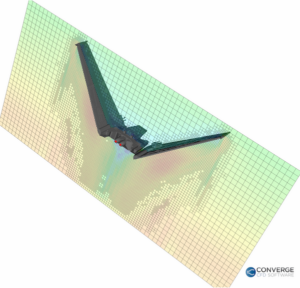
Author:
Kelly Senecal
Owner and Vice President of Convergent Science
From the Toward Predictive Combustion blog series
A long time ago in a galaxy far, far away… I wrote my last blog! Why has it taken me so long to blog again? Really there’s no excuse, but we at Convergent Science have been busy adding offices, forming partnerships, hosting user conferences, and expanding the CONVERGE user base. One thing that hasn’t changed is our dedication to bringing our users the most accurate CFD software for simulating flow and combustion in complex geometries.
An often overlooked concept that is critical to achieving reliable CFD results is order of accuracy. This concept is something that every CFD student learns about and every CFD user should understand. But what is it? It’s all about error. A numerical algorithm is nth order accurate if its error is proportional to the computational cell size to the nth power. In other words, if a method is first order accurate (e.g., first order upwinding), its error shrinks linearly as the cell size is reduced. A method that is second order accurate (e.g., second order central) has its error shrink in a quadratic manner. So what does order of accuracy have to do with predictive combustion modeling? Patience you must have my young Padawan…
If you’ve seen Star Wars: The Force Awakens, then you’re familiar with the First Order, an organization fighting for control of the galaxy. In the official novelization of the movie (according to Wookieepedia), Kylo Ren proclaims, “It is the task of the First Order to remove the disorder from our own existence, so that civilization may be returned to the stability that promotes progress.”

So the goal of the First Order is to remove disorder and return stability. This is exactly what first-order upwinding does to a CFD solution through numerical viscosity! However, by removing the disorder, the smeared flow field will suffer from reduced accuracy and can give a false sense of repeatability for systems that are inherently nonlinear. For example, if you examine 100 cycles of experimental pressure traces from a gasoline direct injection engine, most likely you will see significant cycle-to-cycle variation due to perturbations in one or more quantities. If you simulate this engine with first-order upwinding, however, you are likely to see very similar pressure traces for all 100 cycles, even with similar perturbations. Although a repeatable result may be desirable, you must proceed with caution when simulating combustion systems that exhibit chaotic behavior. Why? Because the cycle you obtain may not resemble the average behavior of the system and because it’s often the extreme cycles that lead to phenomena such as engine knock and high emissions.
A higher order scheme such as second-order central differencing is much more likely to capture complex phenomena such as engine knock and high emissions, and, indeed, second-order central is recommended to achieve accurate results. Nonetheless, local non-monotonic behavior in the solution can lead to instabilities and possibly crashes, and, like the First Order, adding some amount of first-order upwinding is necessary to reduce the disorder of the system and to maintain stability in the solution. It just goes to show that, every so often, even numerical schemes can surrender to the power of the dark side.


